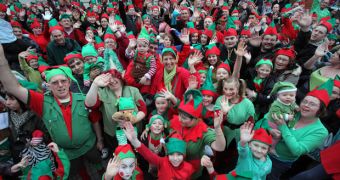Saint Nick's job may seem really simple but, after scientists calculated all of the job’s perks, they explain how complicated it can get. Researchers teamed up and with a few fun info-graphics and explained the whole science behind Santa and his elves' work.
A series of questions were selected by the founders of The Big Bang UK Young Scientists and Engineers Fair and the economists from the Center of Economics and Business Research in order to offer children some scientific answers to their curiosity.
Based on official population studies, there are almost 1.6 billion children around the world that expect Father Christmas' visit on the holidays and, taking into consideration the difference of time zones, that gives Mr. Claus 32 hours to complete his mission. From this simple math calculation, estimations say Santa will be visiting 5,556 home a second on Christmas Eve in order for every kid to receive their gift, notes Daily Mail.
After another calculation to estimate the average number of children per household, it was explained that the Christmas symbol would have to make almost 640 million stops and consume 150 billion calories in milk and cookies left by children. All those calories in just one night means 60,000 time more than his recommended daily intake.
In order to help Saint Nick stay fit, the researchers calculated the amount of exercise he will need to do to shed the extra pounds and the result was that he would need to walk 1.3 billion miles, almost 54,000 times around the planet Earth.
Concerning the packaging of the presents, one elf must be able to finish wrapping a gift in 10 seconds, and 3,000 elves must work eight hours a day for a full year to get all of them done. The expenses estimated for the holiday spree reach the astonishing amount of $456.81 (€332) billion without mentioning the prices of storage and other facilities.
“With Christmas on its way, we thought that calculating the ‘science of Santa’ would be a great way to get young people, parents and even Santa himself thinking about how important science, math, engineering and technology are,” Paul Jackson, chief executive of EngineeringUK, said, according to Daily Mail.
After all these calculations and statistics, Santa Claus' job has proven to be more than difficult, but there is nothing a little holiday magic can't do.

 14 DAY TRIAL //
14 DAY TRIAL //